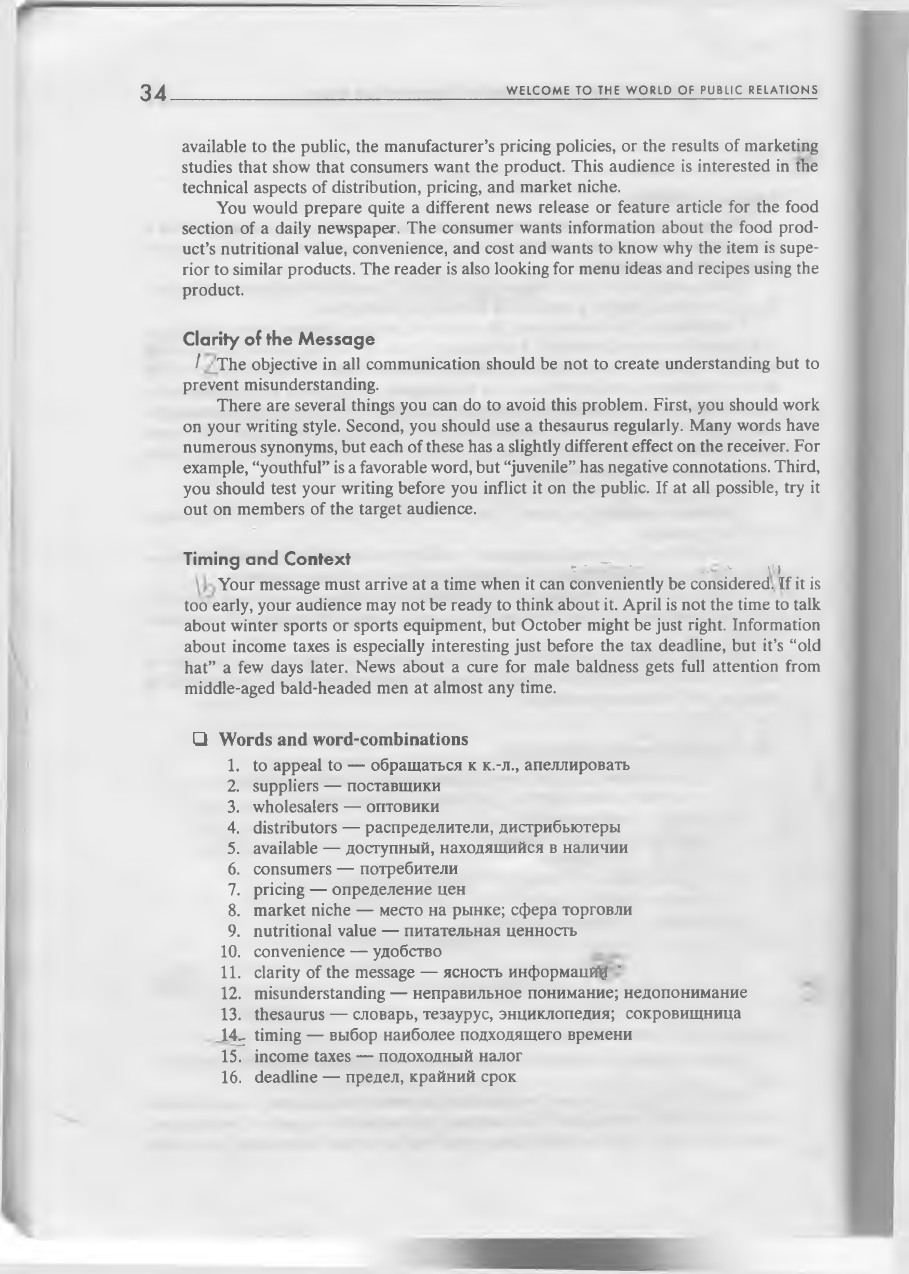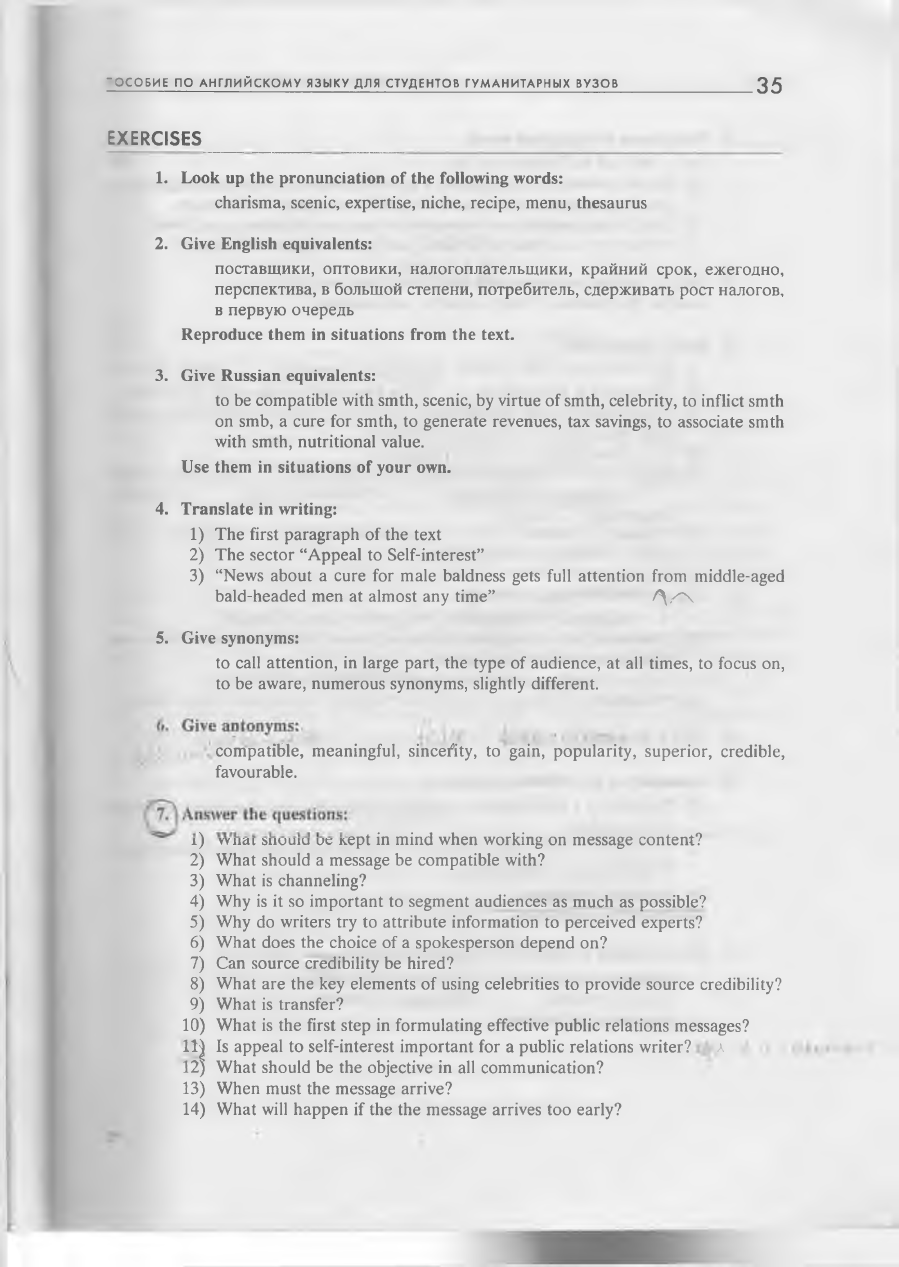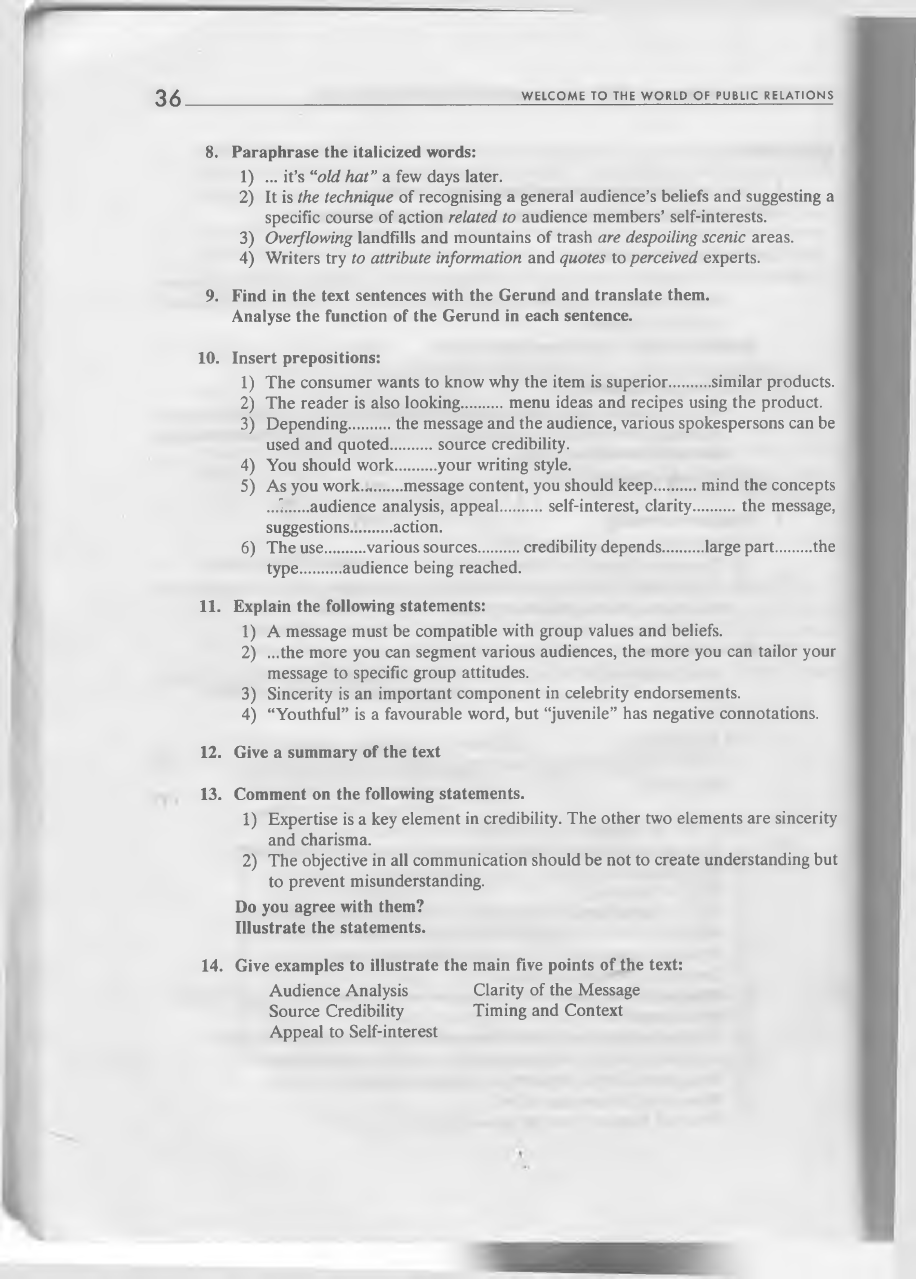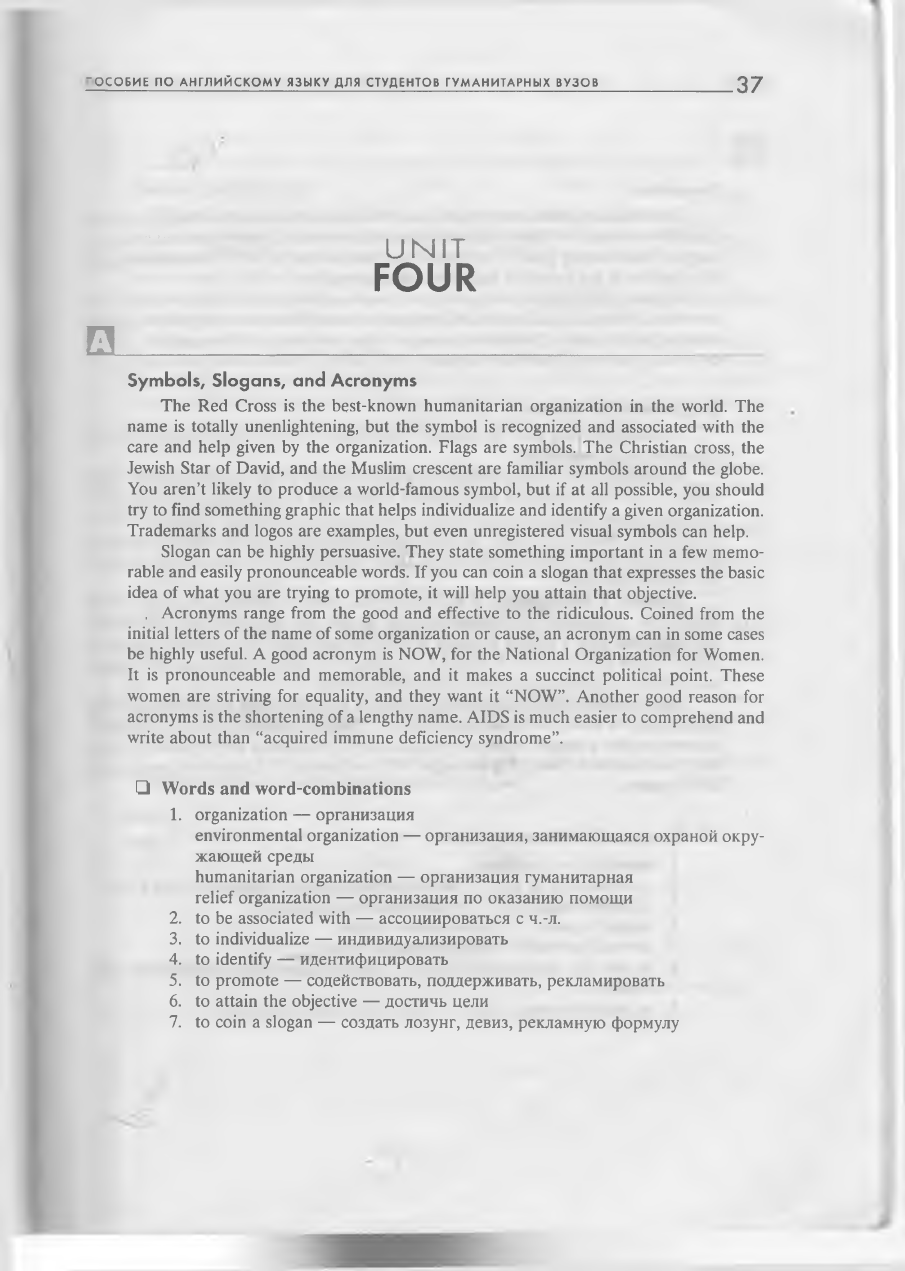ВУЗ: Не указан
Категория: Не указан
Дисциплина: Не указана
Добавлен: 01.04.2021
Просмотров: 1556
Скачиваний: 7

: : О Б И Е П О А Н Г Л И Й С К О М У Я З Ы К У Д Л Я С Т У Д Е Н Т О В Г У М А Н И Т А Р Н Ы Х В У З О В _________________________________ 3 3
Sogrce Credibility
message is more believable to an audience if the source has credibility. That is
why writers try to attribute information and quotes to perceived experts; it makes the
material more persuasive.
Indeed, expertise is a key element in credibility. The other two elements are sincer
ity and charisma. Ideally, a source will have all three attributes.
Depending on the message and the audience, various spokespersons can be used
and quoted for source credibility. For example, if you are writing a news release about
a new product for a trade magazine, perhaps the best source to quote would be the
director of research and development for the company. This person is a credible source
primarily because of personal knowledge and expertise. If the news release is about the
fourth-quarter earnings of the company , the most credible person to quote in the news
release would be either the chief executive officer or the vice president for finance, both
experts by virtue of their position.
^ Source credibility also can be hired.
Additional credibility is gained if the spokesperson comes across as being sincere
about the message.
Sincerity is an important component in celebrity endorsement^jSincerity and cha
risma are the key elements of using celebrities to provide source credibility.
Celebrities are used primarily to call attention to a product, service or idea. The
sponsor’s intent is to associate the person’s popularity with the product. This is called
transfer.
The use of various sources for credibility depends in large part on the type of
audience being reached. That is whwiudience analysis is the first step in formulating
effective public relations messages.
□ Words and word-combinations
1. source credibility — достоверность источника (информации)
2. to attribute information to — приписать информацию к.-л.
3. sincerity — искренность
4. charisma — харизма, обаяние
5. to quote — цитировать
6. to gain credibility — получить доверие (добиться)
7. to endorse smth — подтверждать, поддерживать
8. transfer — перевод, трансферт
Appeal to Self-interest
A public relations writer must at all times be aware of what the audience wants to
know.
Writing publicity for a new food product can serve as an example. A news release
to the trade press serving the food industry (grocery stores, suppliers, wholesalers,
distributors) might focus on how the product was developed, distributed, and made

34
W E L C O M E T O T H E W O R L D O F P U B L I C R E L A T I O N S
available to the public, the manufacturer’s pricing policies, or the results of marketing
studies that show that consumers want the product. This audience is interested in the
technical aspects of distribution, pricing, and market niche.
You would prepare quite a different news release or feature article for the food
section of a daily newspaper. The consumer wants information about the food prod
uct’s nutritional value, convenience, and cost and wants to know why the item is supe
rior to similar products. The reader is also looking for menu ideas and recipes using the
product.
Clarity of the Message
/ The objective in all communication should be not to create understanding but to
prevent misunderstanding.
There are several things you can do to avoid this problem. First, you should work
on your writing style. Second, you should use a thesaurus regularly. Many words have
numerous synonyms, but each of these has a slightly different effect on the receiver. For
example, “youthful” is a favorable word, but “juvenile” has negative connotations. Third,
you should test your writing before you inflict it on the public. If at all possible, try it
out on members of the target audience.
Timing and Context
. ~ ,
»
C. V v .
. л . -V
h j
Your message must arrive at a time when it can conveniently be considered. If it is
too early, your audience may not be ready to think about it. April is not the time to talk
about winter sports or sports equipment, but October might be just right. Information
about income taxes is especially interesting just before the tax deadline, but it’s “old
hat” a few days later. News about a cure for male baldness gets full attention from
middle-aged bald-headed men at almost any time.
□ Words and word-combinations
1. to appeal to — обращаться к к.-л., апеллировать
2. suppliers — поставщики
3. wholesalers — оптовики
4. distributors — распределители, дистрибьютеры
5. available — доступный, находящийся в наличии
6. consumers — потребители
7. pricing — определение цен
8. market niche — место на рынке; сфера торговли
9. nutritional value — питательная ценность
10. convenience — удобство
11. clarity of the message — ясность информации '
12. misunderstanding — неправильное понимание; недопонимание
13. thesaurus — словарь, тезаурус, энциклопедия; сокровищница
14r timing — выбор наиболее подходящего времени
15. income taxes — подоходный налог
16. deadline — предел, крайний срок

" Э С О Б И Е П О А Н Г Л И Й С К О М У Я З Ы К У Д Л Я С Т У Д Е Н Т О В Г У М А Н И Т А Р Н Ы Х В У З О В
35
EXERCISES
1. Look up the pronunciation of the following words:
charisma, scenic, expertise, niche, recipe, menu, thesaurus
2. Give English equivalents:
поставщики, оптовики, налогоплательщики, крайний срок, ежегодно,
перспектива, в большой степени, потребитель, сдерживать рост налогов,
в первую очередь
Reproduce them in situations from the text.
3. Give Russian equivalents:
to be compatible with smth, scenic, by virtue of smth, celebrity, to inflict smth
on smb, a cure for smth, to generate revenues, tax savings, to associate smth
with smth, nutritional value.
Use them in situations of your own.
4. Translate in writing:
1) The first paragraph of the text
2) The sector “Appeal to Self-interest”
3) “News about a cure for male baldness gets full attention from middle-aged
bald-headed men at almost any time”
/ \ s \
5. Give synonyms:
to call attention, in large part, the type of audience, at all times, to focus on,
to be aware, numerous synonyms, slightly different.
1
)
w i i a i m i u u i u u c
K.ept in mind when working on message content?
2) What should a message be compatible with?
3) What is channeling?
4) Why is it so important to segment audiences as much as possible?
5) Why do writers try to attribute information to perceived experts?
6) What does the choice of a spokesperson depend on?
7) Can source credibility be hired?
8) What are the key elements of using celebrities to provide source credibility?
9) What is transfer?
10) What is the first step in formulating effective public relations messages?
11) Is appeal to self-interest important for a public relations writer?
a
12) What should be the objective in all communication?
13) When must the message arrive?
14) What will happen if the the message arrives too early?
compatible, meaningful, sincerity, to gain, popularity, superior, credible,
favourable.

36
W E L C O M E T O T H E W O R L D O F P U B L I C R E L A T I O N S
8
. Paraphrase the italicized words:
1) ... it’s “
old hat
” a few days later.
2) It is
the technique
of recognising a general audience’s beliefs and suggesting a
specific course of action
related to
audience members’ self-interests.
3)
Overflowing
landfills and mountains of trash
are despoiling scenic
areas.
4) Writers try
to attribute information
and
quotes
to
perceived
experts.
9. Find in the text sentences with the Gerund and translate them.
Analyse the function of the Gerund in each sentence.
10. Insert prepositions:
1) The consumer wants to know why the item is superior......... similar products.
2) The reader is also looking......... menu ideas and recipes using the product.
3) Depending......... the message and the audience, various spokespersons can be
used and quoted......... source credibility.
4) You should work......... your writing style.
5) As you work......... message content, you should keep....... mind the concepts
...^......audience analysis, appeal.... .
self-interest, clarity......... the message,
suggestions..........action.
6) The use......... various sources......... credibility depends.......... large part........ the
type......... audience being reached.
11. Explain the following statements:
1) A message must be compatible with group values and beliefs.
2) ...the more you can segment various audiences, the more you can tailor your
message to specific group attitudes.
3) Sincerity is an important component in celebrity endorsements.
4) “Youthful” is a favourable word, but “juvenile” has negative connotations.
12. Give a summary of the text
13. Comment on the following statements.
1) Expertise is a key element in credibility. The other two elements are sincerity
and charisma.
2) The objective in all communication should be not to create understanding but
to prevent misunderstanding.
Do you agree with them?
Illustrate the statements.
14. Give examples to illustrate the main five points of the text:
Audience Analysis
Clarity of the Message
Source Credibility
Timing and Context
Appeal to Self-interest

~ О С О Б И Е П О А Н Г Л И Й С К О М У Я З Ы К У Д Л Я С Т У Д Е Н Т О В Г У М А Н И Т А Р Н Ы Х В У З О В
37
U N I T
FOUR
Symbols, Slogans, and Acronyms
The Red Cross is the best-known humanitarian organization in the world. The
name is totally unenlightening, but the symbol is recognized and associated with the
care and help given by the organization. Flags are symbols. The Christian cross, the
Jewish Star of David, and the Muslim crescent are familiar symbols around the globe.
You aren’t likely to produce a world-famous symbol, but if at all possible, you should
try to find something graphic that helps individualize and identify a given organization.
Trademarks and logos are examples, but even unregistered visual symbols can help.
Slogan can be highly persuasive. They state something important in a few memo
rable and easily pronounceable words. If you can coin a slogan that expresses the basic
idea of what you are trying to promote, it will help you attain that objective.
. Acronyms range from the good and effective to the ridiculous. Coined from the
initial letters of the name of some organization or cause, an acronym can in some cases
be highly useful. A good acronym is NOW, for the National Organization for Women.
It is pronounceable and memorable, and it makes a succinct political point. These
women are striving for equality, and they want it “NOW”. Another good reason for
acronyms is the shortening of a lengthy name. AIDS is much easier to comprehend and
write about than “acquired immune deficiency syndrome”.
□ Words and word-combinations
1. organization — организация
environmental organization — организация, занимающаяся охраной окру
жающей среды
humanitarian organization — организация гуманитарная
relief organization — организация по оказанию помощи
2. to be associated with — ассоциироваться с ч.-л.
3. to individualize — индивидуализировать
4. to identify — идентифицировать
5. to promote — содействовать, поддерживать, рекламировать
6. to attain the objective — достичь цели
7. to coin a slogan — создать лозунг, девиз, рекламную формулу
□